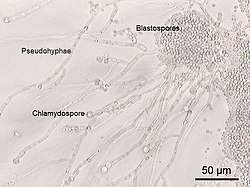Candida albicans (sputum)
ID#: 9812
This transmission photomicrograph depicted a number of Candida albicans chlamydospores, or chlamydoconidium that were present in a sputum specimen. Chlamydospores are the round terminal asexual segments of the asexual conidium, which are not shed at maturity. C. albicans is a yeast-like member of the phylum known as Deuteromycota, or “Fungi Imperfecti, and is the etiologic agent responsible for the disease, ”Candidiasis”.
The clinical features of candidiasis depend upon whether or not the ailment is oropharyngeal, vulvovaginal, or systemic in nature. Oropharyngeal candidiasis manifests as white oropharygeal mucosal patches. Vulvovaginal candidiasis includes symptoms of purities, vulval erythema, and may, or may not present a discharge. Systemic infection usually presents as a fever and chills, and is unresponsive to antibacterial therapy; may manifest as renal or hepatosplenic infection, meningitis, endophthalmitis, endocarditis, osteomyelitis and/or arthritis.Relevante Bilder
Relevante Artikel
Candida albicansCandida albicans, der „Soorpilz“, ist ein Pilz der Candidagruppe, die den Hefepilzen zugeordnet wird. Er ist der häufigste Erreger der Kandidose. Dieser Pilz ist bei Gleichwarmen („Warmblüter“) und somit auch beim Menschen häufig auf den Schleimhäuten von Mund und Rachen und im Genitalbereich sowie im Verdauungstrakt zu finden. Bei etwa 75 % aller gesunden Menschen kann er laut der Deutschen Gesellschaft für Ernährung nachgewiesen werden. Der Pilz kann auch zwischen Fingern und Zehen sowie auf den Finger- und Fußnägeln vorkommen. .. weiterlesen

